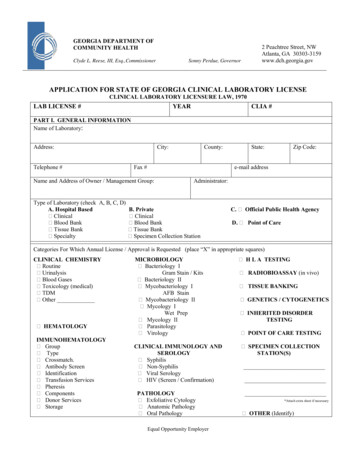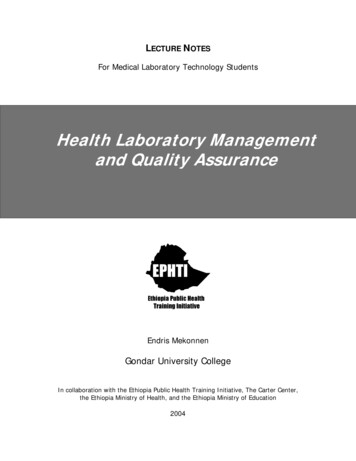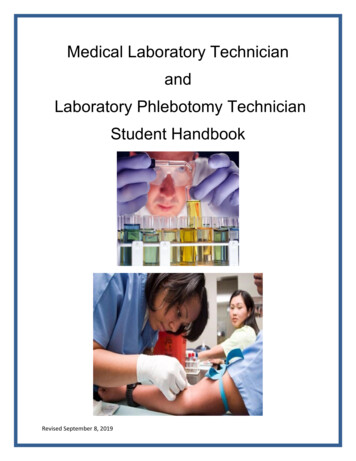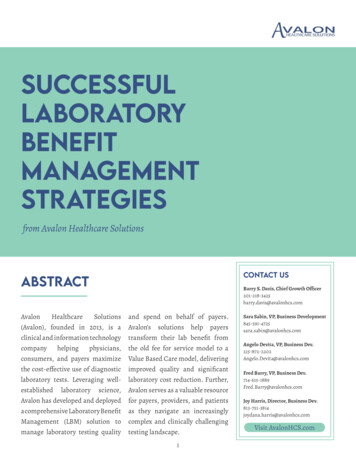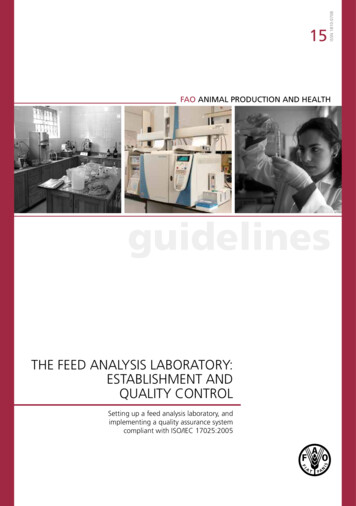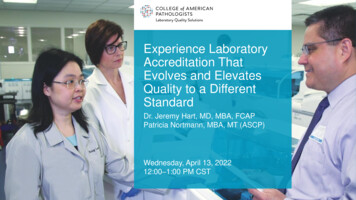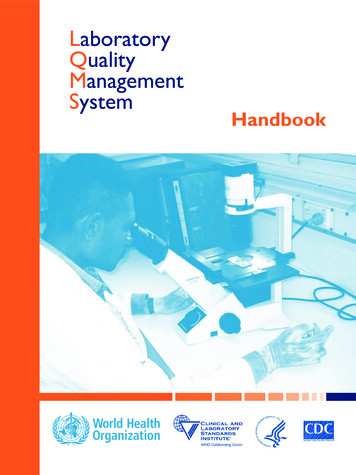
Transcription
LaboratoryQualityManagementSystemHandbook
WHO Library Cataloguing-in-Publication DataLaboratory quality management system: handbook.1.Laboratories — organization and administration. 2. Laboratories — handbooks.3.Laboratories techniques and procedures — standards. 4.Quality control. 5.Manuals.I.World Health Organization.ISBN 978 92 4 154827 4(NLM classification: QY 25)Version 1.1 World Health Organization 2011All rights reserved. Publications of the World Health Organization are available on theWHO web site (www.who.int) or can be purchased from WHO Press, World HealthOrganization, 20 Avenue Appia, 1211 Geneva 27, Switzerland (tel.: 41 22 791 3264; fax: 41 22 791 4857; e-mail: bookorders@who.int).Requests for permission to reproduce or translate WHO publications – whether for saleor for noncommercial distribution – should be addressed to WHO Press through theWHO web site (http://www.who.int/about/licensing/copyright form/en/index.html).The designations employed and the presentation of the material in this publication donot imply the expression of any opinion whatsoever on the part of the World HealthOrganization concerning the legal status of any country, territory, city or area or of itsauthorities, or concerning the delimitation of its frontiers or boundaries. Dotted lines onmaps represent approximate border lines for which there may not yet be full agreement.The mention of specific companies or of certain manufacturers’ products does not implythat they are endorsed or recommended by the World Health Organization in preferenceto others of a similar nature that are not mentioned. Errors and omissions excepted, thenames of proprietary products are distinguished by initial capital letters.All reasonable precautions have been taken by the World Health Organization to verifythe information contained in this publication. However, the published material is beingdistributed without warranty of any kind, either expressed or implied. The responsibilityfor the interpretation and use of the material lies with the reader. In no event shall theWorld Health Organization be liable for damages arising from its use.Printed in FranceContactsWHO Lyon Office – International Health Regulations Coordination58 avenue Debourg – 69007 Lyon – Franceihrinfo@who.intCDC – National Center for Preparedness, Detection and Control of InfectiousDiseases (NCPDCID)1600 Clifton Road – Atlanta, GA – USAQMS toolkit@CDC.govClinical and Laboratory Standards Institute940 West Valley Road, Suite 1400Wayne, PA 19087 – USAcustomerservice@clsi.orgLaboratory Quality Management System
Table of contentsAcknowledgements .p 6Foreword.p 7Key words.p 81. Introduction to quality.p 91-1: The importance of laboratory quality.p 101-2: Overview of the quality management system .p 111-3: The quality management system model.p 131-4: History of laboratory quality management .p 161-5: International laboratory standards.p 171-6: Summary.p 182. Facilities and safety. p 192-1: Overview.p 202-2: Laboratory design .p 222-3: Geographic or spatial organization .p 232-4: Physical aspects of premises and rooms.p 242-5: Safety management programme .p 252-6: Identification of risks .p 272-7: Personal protective equipment.p 312-8: Emergency management and first aid.p 322-9: Summary.p 343. Equipment. p 353-1: Overview .p 363-2: Selecting and acquiring equipment .p 383-3: Getting equipment ready for service .p 403-4: Implementing an equipment maintenance programme.p 423-5: Troubleshooting, service, repair and retiring equipment .p 443-6: Equipment maintenance documentation .p 463-7: Summary.p 484. Purchasing and inventory. p 494-1: Overview .p 504-2: Purchasing .p 524-3: Implementing an inventory management programme .p 534-4: Quantification.p 544-5: Forms and logs .p 564-6: Receipt and storage of supplies.p 574-7: Monitoring inventory .p 594-8: Summary.p 605. Process control—sample management . p 615-1: Overview.p 625-2: The laboratory handbook.p 635-3: Collection and preservation .p 645-4: Sample processing.p 665-5: Sample storage, retention and disposal .p 685-6: Sample transport .p 695-7: Summary.p 72Laboratory Quality Management System3
6. Process control—introduction to quality control. p 736-1: Introduction .p 747. Process control—quality control for quantitative tests. p 777-1: Overview .p 787-2: Control materials .p 797-3: Establishing the value range for the control material.p 817-4: Graphically representing control ranges.p 867-5: Interpreting quality control data .p 877-6: Using quality control information .p 897-7: Summary.p 908. Process control—quality control for qualitative andsemiquantitative procedures. p 918-1: Overview.p 928-2: Quality control materials .p 948-3: Quality control of stains.p 968-4: Quality control of microbiological media.p 988-5: Summary. p 1009. Assessment—audits. p 1019-1: Overview . p 1029-2: External audit. p 1059-3: Internal audit. p 1079-4: Internal audit programme. p 1089-5: Actions as result of audit . p 1109-6: Summary . p 11110. Assessment—external quality assessment . p 11310-1: Overview. p 11410-2: Proficiency testing. p 11710-3: Other external quality assessment methods . p 11910-4: Comparison of external quality assessment methods. p 12110-5: Managing external quality assessment in the laboratory. p 12210-6: Summary. p 12411. Assessment—norms and accreditation. p 12511-1: Overview. p 12611-2: International standards and standardization bodies . p 12711-3: National standards and technical guidelines . p 12911-4: Certification and accreditation. p 13111-5: Process of accreditation. p 13411-6: Benefits of accreditation . p 13511-7: Summary. p 13612. Personnel . p 13712-1: Overview . p 13812-2: Recruitment and orientation . p 14012-3: Competency and competency assessment . p 14212-4: Training and continuing education. p 14512-5: Employee performance appraisal . p 14712-6: Personnel records. p 14912-7: Summary. p 1504Laboratory Quality Management System
13. Customer service. p 15113-1: Overview . p 15213-2: The laboratory clients—the customers . p 15413-3: Assessing and monitoring customer satisfaction . p 15713-4: Customer satisfaction surveys. p 15813-5: Summary. p 16014. Occurrence management . p 16114-1: Overview. p 16214-2: Sources and consequences of laboratory error. p 16314-3: Investigation of occurrences. p 16514-4: Rectifying and managing occurrences. p 16614-5: Summary. p 16815. Process improvement . p 16915-1: Continual improvement concept. p 17015-2: Tools for process improvement. p 17215-3: Quality indicators. p 17415-4: Selecting quality indicators. p 17515-5: Implementing process improvement. p 17815-6: Summary . p 18016. Documents and records. p 18116-1: Introduction. p 18216-2: Overview of documents. p 18316-3: The quality manual. p 18616-4: Standard operating procedures (SOPs). p 18716-5: Document control. p 19016-6: Overview of records. p 19316-7: Storing documents and records. p 19516-8: Summary. p 19617. Information management. p 19717-1: Overview. p 19817-2: Elements of information management. p 19917-3: Manual paper-based systems. p 20217-4: Computerized laboratory information systems. p 20417-5: Summary. p 20718. Organization. p 20918-1: Organizational requirements for a quality management system. p 21018-2: Management role. p 21218-3: Organizational structure. p 21418-4: Organizational functions: planning. p 21618-5: Organizational functions: implementation. p 21818-6: The laboratory quality manual. p 22018-7: Summary. p 222Glossary . . p 223Acronyms. p 235References and resources by chapter. p 237Notes. p 245Laboratory Quality Management System5
AcknowledgementsThis handbook was developed through collaboration between the WHO LyonOffice for National Epidemic Preparedness and Response, the United Statesof America Centers for Disease Control and Prevention (CDC) Division ofLaboratory Systems, and the Clinical and Laboratory Standards Institute (CLSI).It is based on training sessions and modules provided by the CDC and WHO inmore than 25 countries, and on guidelines for implementation of ISO 15189 indiagnostic laboratories, developed by CLSI.WHO, the CDC and the CLSI would like to acknowledge with thanks all thosewho contributed to the development and review of this training package, morespecifically:Adilya AlbetkovaRobin BartelukAnouk BergerSébastien CognatCarlyn CollinsPhilippe DuboisChristelle EstranGlen FineSharon GranadeStacy HowardDevery HowertonKazunobu KojimaXin LiuJennifer McGearyRobert MartinSylvio MennaMichael NobleAntoine PiersonAnne PollockMark RayfieldJohn RidderhofEunice RosnerJoanna Zwetyenga6Laboratory Quality Management System
ForewordAchieving, maintaining and improving accuracy, timeliness and reliability are majorchallenges for health laboratories. Countries worldwide committed themselvesto build national capacities for the detection of, and response to, public healthevents of international concern when they decided to engage in the InternationalHealth Regulations implementation process.Only sound management of quality in health laboratories will enable countriesto produce test results that the international community will trust in cases ofinternational emergency.This handbook is intended to provide a comprehensive reference on LaboratoryQuality Management System for all stakeholders in health laboratory processes,from management, to administration, to bench-work laboratorians.This handbook covers topics that are essential for quality management of a publichealth or clinical laboratory. They are based on both ISO 15189 and CLSIGP26-A3 documents.Each topic is discussed in a separate chapter. The chapters follow the frameworkdeveloped by CLSI and are organized as the “12 Quality System Essentials”. Adiagram representing these 12 essentials is shown tory Quality Management System7
Note:Health laboratories, in this handbook, is a term that is meant to be inclusiveof clinical laboratories, diagnostic laboratories, medical laboratories, publichealth laboratories, animal and environmental health laboratories or any otherlaboratories performing testing for the purpose of disease diagnosis, screening,prevention, medical treatment decisions, surveillance or public health. Because allthese terms for laboratories are frequently used interchangeably, the terms maylikewise be used interchangeably in this handbook.Revision information:The version 1.1 of the present handbook includes updated Glossary, Acronyms,and References and resources by chapter sections.Key wordsLaboratory quality management system, laboratory quality, laboratory qualitysystems, laboratory information management, laboratory information system,laboratory documents and records, laboratory quality manual, quality control,laboratory facilities and safety, laboratory equipment, laboratory samplemanagement, laboratory sample transport, laboratory purchasing and inventory,laboratory assessment, laboratory customer service, occurrence management,process improvement, quality essentials, laboratory process control, clinicallaboratory, ISO 15189.8Laboratory Quality Management System
1. Introduction toquality
1-1: The importance of laboratory qualityDefinition ofqualityLaboratory quality can be defined as accuracy, reliability and timeliness of reportedtest results. The laboratory results must be as accurate as possible, all aspects ofthe laboratory operations must be reliable, and reporting must be timely in orderto be useful in a clinical or public health setting.Level of accuracyrequiredWhen making measurements, there is always some level of inaccuracy. Thechallenge is to reduce the level of inaccuracy as much as possible, given thelimitations of our testing systems. An accuracy level of 99% may at first glanceappear acceptable, but the resulting 1% error can become quite large in a systemwhere many events occur, such as laboratory testing.Negativeconsequences oflaboratory errorLaboratories produce test results that are widely used in clinical and publichealth settings, and health outcomes depend on the accuracy of the testingand reporting. If inaccurate results are provided, the consequences can be verysignificant, including:yy unnecessary treatmentyy treatment complicationsyy failure to provide the proper treatmentyy delay in correct diagnosisyy additional and unnecessary diagnostic testing.These consequences result in increased cost in time and personnel effort, andoften in poor patient outcomes.Minimizinglaboratory error10In order to achieve the highest level of accuracy and reliability, it is essentialto perform all processes and procedures in the laboratory in the best possibleway. The laboratory is a complex system, involving many steps of activity andmany people. The complexity of the system requires that many processes andprocedures be performed properly. Therefore, the quality management systemmodel, which looks at the entire system, is very important for achieving goodlaboratory performance.Laboratory Quality Management System
1-2: Overview of the quality management systemDefinition ofqualitymanagementsystemA quality management system can be defined as “coordinated activities to directand control an organization with regard to quality”. This definition is used bythe International Organization for Standardization (ISO) and by the Clinical andLaboratory Standards Institute (CLSI). Both groups are internationally recognizedlaboratory standards organizations, and will be discussed later in this handbook.In a quality management system, all aspects of the laboratory operation, includingthe organizational structure, processes and procedures, need to be addressed toassure quality.Patient client prepSample ersonnel competencytest evaluationsHIGHLOWSample receipt andaccessioningRecord keepingSample transportExComplexityof laboratoryprocessesQuality controltestingaminationThere are many procedures and processes that are performed in the laboratory,and each of these must be carried out correctly in order to assure accuracyand reliability of testing. An error in any part of the cycle can produce a poorlaboratory result. A method of detecting errors at each phase of testing is neededif quality is to be assured.Laboratory Quality Management System11
1-2: Overview of the quality management systemISO standards group laboratory processes into pre-examination, examinationand post-examination categories. Comparable terms in current laboratory useinclude: pre-analytic, analytic and post-analytic processes; or pre-test, test andpost-test processes.Path of workflowThe entire set of operations that occur in testing is called the path of workflow.The path of workflow begins with the patient and ends in reporting and resultsinterpretation, as shown in the figure below.The concept of the path of workflow is a key to the quality model or the qualitymanagement system, and must be considered when developing quality practices.For example, a sample that is damaged or altered as a result of impropercollection or transport cannot provide a reliable result. A medical report thatis delayed or lost, or poorly written, can negate all the effort of performing thetest well.The patientTestselectionPr e e xa mi na tiSamplecollectiono n phaseSampletr
aboratory Quality Management System. WHO Library Cataloguing-in-Publication Data Laboratory quality management system: handbook. 1.Laboratories — organization and administration. 2. Laboratories — handbooks. 3.Laboratories techniques and procedures — standards. 4.Quality control. 5.Manuals. I.World Health Organization.

